Blue Heron Bridge, located in Riviera Beach, Florida, has consistently been rated as one of the country’s top dive sites not just in West Palm Beach, but also in the country as well. This Florida paradise is home to more than 100 species of tropical fish and the possibility of getting a glimpse of all of them is high even with just one dive. In this article, we’re here to help you get to Blue Heron Bridge, find the best snorkeling spots, as well as know other activities you can do to explore Florida’s diverse marine life.
Blue Heron Bridge snorkeling guide
Preparing the essentials before going to Blue Heron Bridge is a must for you to have a wonderful time overall. It’s recommended to secure a dive map for the area, identify the best times to dive in a snorkeling spot, the types of fish to see at Blue Heron Bridge, as well as know the rules to follow in West Palm Beach in order to get the most out of your trip.
Starting your snorkeling adventure at Blue Heron Bridge
What is Blue Heron Bridge exactly, and how do you go from there? BHB connects Signer Island to the mainland of Florida. To get to the trail, you’ll have to take Blue Heron Boulevard towards Signer Island and turn left towards the park sign. There are lots of free parking available in the vicinity as well as restrooms and outdoor showers. However, it’s recommended to arrive early as parking spaces can be full as early as 08:00 AM. Arriving late means you’ll have to park much farther than intended. In addition, a supermarket is just within a short distance if you want to stock up on food and drinks during your vacation.
Now that you’re in the area, simply go to the dive staging and entry locations beneath the bridge to start your adventures. Blue Heron Bridge has a trail map of up to 800 feet in length. As mentioned earlier, it’s recommended to secure a dive map for your own, as you’ll be able to locate a lot of easy access to the sandy beaches easily. The average water depth in Blue Heron Bridge is around 5 to 20 feet making it the perfect location for first-time and even seasoned snorkelers and divers.
The best time to do snorkeling and diving meanwhile is during slack high tide. There are a lot of dive and snorkeling shops for getting your own gear or renting equipment for your adventures. Most snorkeling spots in Phil Foster Park are protected with buoys to prevent boats from entering designated snorkeling spots. You’ll often find experienced divers diving the bridge for up to 90 minutes to see everything at a leisurely pace. Underwater photographers take snapshots of the wide variety of aquatic life, and a lot of students as well as newbie divers practice their skills snorkeling and diving. Blue Heron Bridge is a favorite among local dive centers for swimming, snorkeling, and diving lessons and you’ll often encounter a lot of classes being conducted every day.
In ideal conditions, it’s possible to see up to 100 different marine species on the same dive, especially if you spend up to 2 hours underwater. Before going into the water though, it’s best to observe the currents for up to 10 to 20 minutes before determining if snorkeling and diving are safe in your chosen spot. Studying the day’s tide charts before you go to the beach also helps you prepare for any sudden weather changes.
What and where are the main attractions when snorkeling on Blue Heron Bridge?
The dive depths of Blue Heron Bridge can range from 5 – 20 feet making it one of the popular snorkeling spots for beginners and experienced divers. Without even dipping your toes into the waters, you can already see all the fish due to how clear the waters are. One of the main attractions of BHB includes a smaller bridge on the southeast side and another larger bridge on the southwest side. They’re separated by a beach containing the park’s snorkeling trails as well as the main swimming area. The smaller bridge, or “Old Bridge” as the locals call it, has a lot of sweet snorkeling spots teeming with marine life.
The larger bridge, on the other hand, has areas to explore around and under the bridge if you want to mix up your usual snorkeling trail. There are a couple of small wrecks where a wide range of marine life took over and claimed it as their home. These include sea horses, frogfish, as well as other exotic and interesting fish species to fill your senses. The wide assortment of marine life in such a small area is a feast for first-time divers. Seeing an octopus, manta rays, or even a manatee is not uncommon.
Aside from the abundant tropical fish at Blue Heron Bridge, what other marine creatures should I expect to find?
The famous park is home to a lot of marine life and you should keep your eyes peeled down when snorkeling or diving in order to catch a glimpse of these majestic creatures.
Sea Turtle
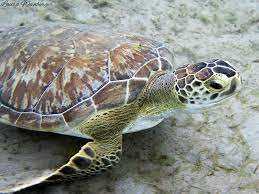
Florida is home to five different sea turtle species such as the loggerhead, green sea turtle, leatherback, Kemp’s Ridley, and the Hawksbill sea turtle. If you’re snorkeling during the months of March through October, Blue Heron Bridge and other nearby beaches serve as some of the busiest sea turtle nesting beaches in the world, and you have a high chance of spotting them without difficulties during these months.
Most turtles spend their time in shallow waters near coral reefs and seagrass. They’re particularly wary of divers and snorkelers so you should be cautious when encountering one during your adventures. Most sea turtles are listed as threatened or endangered and are protected under the endangered species act, so extra care must be taken when you encounter them.
Dolphins
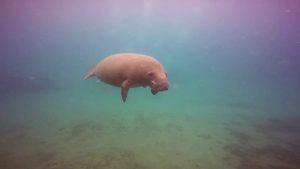
Dolphins are abundant in Florida and it’s easy to spot one when snorkeling on Blue Heron Bridge. Dolphins are highly intelligent and they’re known to sometimes approach divers and snorkelers during your fun times at the beach. They can sometimes be playful particularly when they are young. Mother dolphins let their calf play with snorkelers, divers, and even tourists on a boat to build up their baby’s strength. While dolphins can be spotted almost everywhere on Florida’s beaches, you’re more likely to find one on a boat trip than when snorkeling.
Whale Shark
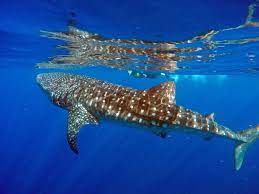
One of the largest fish to look out for when snorkeling is the famous Whale Shark, which is sure to take your breath away. While it’s quite rare to see one up close, you’re likely to see them along deeper coral reef walls as they open their large mouths to feed on plankton and other small creatures.
Spotted Eagle Ray / Manta Ray
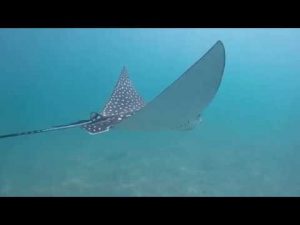
Spotted eagle rays, or manta rays, on the other hand, gracefully glide through waters with ease and it’s also possible to see them make an appearance at Blue Heron Bridge occasionally. They truly represent a sort of mythical creature from ancient writings because of what they look like so be sure to not miss out on them, especially when there’s a rare sighting. Another fun undersea species to look out for is the sea cow, or the manatee.
Manatee
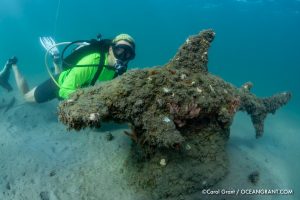
The manatee was once part of the endangered species list but they have now increased in numbers and are now designated as threatened instead. Manatees are gentle giants and are actually closely related to elephants. You’re more likely to find manatees while snorkeling than diving as they spend most of their time in shallow and warm waters. Manatees have a herbivorous diet consisting of seagrass as well as other vegetation, and will seek warmer waters as they try to avoid the cold ocean waters. They’re vulnerable to motorboats as they usually come to the surface every 20 minutes for fresh air which is why it’s illegal to touch manatees when there’s a sighting.
Lionfish
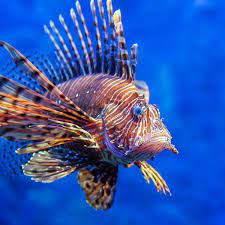
While certainly beautiful, Lionfish are an invasive species and cause harm to coral reefs as they eat basically anything. They pose a great danger to a lot of native fish populations in Florida’s reefs because their appetites know no bounds. They will eat just about anything that fits in their mouth. Lionfish are found in almost all available dive sites in Blue Heron Bridge and all of the beaches in Florida because they spread like mad. The only way to control the lionfish population is by having them actively hunted by humans.
Other marine creatures to take note of
There is another marine life that’s possible to be sighted on Blue Heron Bridge whenever you’re snorkeling or diving. Sharks are abundant in Florida’s waters, and they typically stay offshore and actually shy away when they see divers. The octopus can also be frequently seen in coral reefs around depths of 15 to 75 feet but they’re usually present during the nighttime. Lastly, Goliath Groupers can also be seen when snorkeling and diving, but it’s best to stay away and not get too close to them as these large fish tend to bite when threatened.
Why are there a lot of sharks on Florida’s beaches?
The obvious fact that Florida is surrounded by the ocean means that there is a high chance that you’ll encounter sharks on your trips. This is due to Florida’s proximity to the Gulf Stream, where an abundance of marine life, which includes sharks, migrate in this current for mating and feeding. In addition, the 360-mile Florida reef system that runs from Dry Tortugas National Park located in Key West all the way to St. Lucie Inlet in Martin County is home to the third-largest reef system in the world where marine life is abundant. This attracts predators such as sharks and other creatures.
What are the safety tips to take note of when snorkeling?
For tourists that wish to do other activities aside from snorkeling such as scuba diving, it’s a must to use dive flags to reduce the chances of being injured or even being fined by local law enforcement. There are also boat channels about 100 feet parallel to the shore and under the center of Blue Heron Bridge, so it’s recommended to steer clear if possible or use caution when in the immediate area when scuba diving or snorkeling.
If you’re wondering about the best time to visit Blue Heron Bridge as your next vacation spot, then visiting the famous park is possible all year round as the weather in the area is calm and allows water activities any time of the year. The snorkel trail of Blue Heron Bridge is notorious for being a high-tide spot which means the ocean water stays fresh because of the incoming tide, making water visibility excellent and the reefs full of marine life. If there will be an instance of low tide, however, then it may pose strong currents and low visibility when snorkeling which means underwater activities may not be recommended during such times.
Are night underwater activities possible at Blue Heron Bridge?
For tourists who want to snorkel or dive during the nighttime, it’s only possible by securing a dive permit. There are several dive shops located just near Blue Heron Bridge that issue permits for night dives so you should check that out if you want to mix up the snorkeling experience to include night trips.
Is fishing allowed at Blue Heron Bridge?
Catching fish at Blue Heron Bridge by any means is strictly prohibited. There are numerous signs indicated along the beach to indicate it so fishing by any means, even with spear guns, is not permitted. This ensures marine life thrives at Blue Heron Bridge and that locals, tourists, and vacation goers are encouraged to treat the area as a wildlife preserve. Touching or collecting wildlife is absolutely not allowed.

